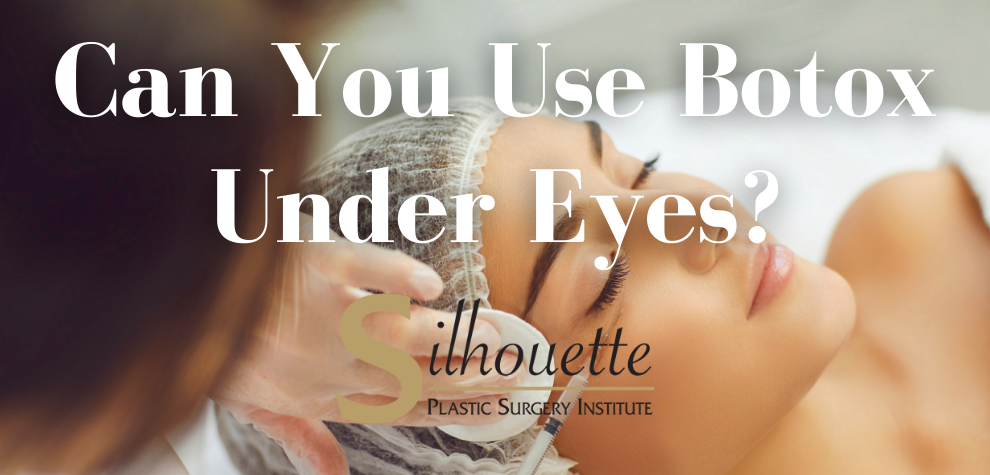When we look in the mirror each morning, it’s never a fun time to find a new wrinkle or crease. Luckily, modern cosmetic advancements in medicine allow us to rectify this issue with ease. Botox under eyes treatments are a recent advancement that allow both men and women to feel comfortable with their skin. At Silhouette Plastic Surgery, Dr. Daneshmand aims to please every single patient. The name of the game is finding a treatment plan that works for you and falls within your comfort zone. If you’re curious about a Botox under eyes treatment, contact us today. Call 949-359-8397 or fill out our online intake form.
How Does Botox Work?
Doctors and medical professionals use Botox as a treatment for both wrinkles and creases on the face. We’ve used this reliable treatment option for years, and its name is actually the brand itself. In other words, Botox is the brand name for a type of toxin called bacterium clostridium botulinum. Other brands, like Dysport and Xeomin, also exist. However, they don’t have quite the name recognition that Botox does. This name recognition comes mainly from the fact that it was the first available brand of injectable botulinum toxins.
Cosmetic professionals use Botox for a wide variety of reasons aside from just treating wrinkles. We list these below.
- To lessen excessive underarm sweating, or hyperhidrosis
- Cervical dystonia, which is a neurological disorder that results in neck and shoulder muscle spasms
- Blepharospasm, or uncontrollable blinking
- Strabismus, or eyes that point in two directions
- Chronic migraines
- An overactive bladder
What to Expect from Botox Injections
The treatment is usually painless for the majority of people. However, if sensitive areas are being treated for hyperhidrosis, you may wish to have your skin anesthetized beforehand. Your doctor may use a variety of techniques to numb the region, including topical anesthetic, cold, and vibration anesthesia, which relies on massage to relieve pain.
In most cases, Botox injections are administered in a doctor’s office. Your doctor injects small quantities of botulinum toxin into your epidermis or muscles with a fine needle. The quantity of injections required is determined by a variety of parameters, including the size of the region to be treated.
For the next 24 hours, do not touch or rub the treated areas. This might help prevent the toxins from spreading to other parts of the body. Following the procedure, you can resume your daily activities.
How Soon Will I See Results from Botox?
The results of Botox can be seen as early as 3 to 4 days after a treatment. The majority of patients will notice improvements in 10 to 14 days, but they should wait the entire 14 days for the best outcomes. While outcomes vary depending on the region treated and the regularity of injections, they usually last three months.
The amount of Botox has an impact on the timeline of effect, in addition to the region treated and the regularity of injections. The longer the impact on the muscles appears to be the larger the dose administered in a certain location. Because of the differences in results, you should address this fine line between dose, desired look, and longevity with your healthcare physician before starting treatment to set correct expectations.
How Long Does Botox Last?
Doesn’t everyone wish Botox could stay indefinitely? Regrettably, it does not. The neurotoxin’s effect will inevitably wear off, and the neurons will be able to transmit signals throughout the body to begin functioning or constricting again. Botox usually lasts 3-4 months.
There will undoubtedly be patients for whom it lasts longer (in the 4-6 month range) or for whom it lasts shorter (in the 2-month range). It’s also usual for first-timers to discover that it doesn’t stay as long at first, but after the second visit, it does. Everyone’s experience is different, and the outcomes may differ.
How Effective Is Botox Under Eyes?
Injecting Botox beneath the eyes to cure bags or dark circles is an off-label application in the United States, and the FDA has not authorized it. As a result, few studies have been undertaken on this topic, and doctors are dubious of its effectiveness.
Botox treatments under and around the eyes were investigated in a 2003 research to see if they may minimize fine lines and wrinkles in these locations. Injections were given to 19 female volunteers. Those who got injections in both the lower eyelids and crow’s feet were more inclined to disclose good results than those who simply had lower eyelid injections.
These findings imply that Botox injections can help decrease wrinkles and bagginess by making the lower eyelid seem larger and plumper. The effects of different dosages of Botox on the lower eyelid were also studied. Patients who had 8 units of Botox had the best outcomes, but they also had the most severe adverse effects. There is presently very little study on Botox injections under the eyes.
How Much Does Botox Under Eyes Cost?
Botox prices differ by area and specialty. A person receiving Botox is responsible for not just the medicine, but also the work of the professional doing the treatment, the office building, and any other materials utilized.
Botox injections in the United States cost between $200 and $1,400, according to the American Board of Cosmetic Surgery. The cost varies as well, depending on the clinic’s location.
When you decide you want Botox under eyes injections, you can ask for a price estimate. An Orange County plastic surgeon can offer an estimate for their services according to how much Botox they use and where their office is located.
Side Effects of Botox Under Eyes
Because Botox for injection beneath the eyes has not been authorized by the FDA, there isn’t a large amount of study on its safety. Botox injections around the eyes are risky due to the sensitive nature of the region. Below, we include the specific risks of the injections.
- Difficulty closing the eyes
- Numbness in the eyes
- Drooping of the eyes
- Swelling in the lower eyelids
Other known side effects of Botox include the following.
- Bruising
- Bleeding
- Fainting
- Dizziness
- Redness
- Pain at the injection site
Botox injections should not be given to those who have certain chronic diseases. Amyotrophic lateral sclerosis, often known as Lou Gehrig’s disease, as well as myasthenia gravis and the Lambert-Eaton syndrome, are among these diseases.
Alternatives to Botox Under Eyes
Botox beneath the eyes can be replaced with home therapies and other injectable drugs. It’s crucial to think about the intended outcome. Techniques for reducing under-eye wrinkles, for example, may differ significantly from those for lightening dark circles.
To begin, a person should assess their daily activities to see if they are contributing to the appearance of bags and wrinkles beneath the eyes. The techniques listed below may be beneficial.
- Getting at least 7 or 8 hours of sleep
- Treating allergies with medications that reduce puffiness in the eyes
- Not smoking
- Avoiding eating too much sodium. This causes the body to retain water, which results in puffy skin.
- Sleep with the head elevated slightly, which stops fluid from collecting in the under eyes
- Avoiding too much sun exposure and wearing sunscreen outside
Certain cosmetic products smooth and soften the skin under the eyes. If eye puffiness is a problem, for example, a person may want to consider using a caffeine-based eye lotion. Caffeine is added by companies because it can help tighten skin and minimize puffiness. Creams developed particularly for the under-eye region may assist if dark circles are a problem.
Fillers other than Botox are sometimes used to increase volume to the under-eye region. Injecting chemicals that can minimize the fine lines and dark shadows on the face is part of this procedure.
Another alternative is laser therapy. These treatments encourage the production of collagen in the skin, giving it a tighter appearance. Laser treatments, on the other hand, may be highly costly, costing thousands of dollars each session.
Who Is a Good Candidate for Botox Under Eyes?
For Botox patients, there aren’t many precise needs. In general, you must be in good health and over 18. In this sense, healthy refers to the absence of any significant medical illnesses or persistent neuromuscular disorders. Botulinum toxin, the chemical from which Botox is generated, must not be an allergen for you. Both men and women are suitable candidates for Botox treatments. In fact, Botox for men is increasingly popular.
Botox is seldom used to treat wrinkles around the eyes. When you have Botox for crow’s feet, you usually get Botox beneath the eyes as well. Botox should not be used if you are pregnant or nursing. Its effects on unborn and breastfeeding newborns are unknown to the medical community.
Contact Silhouette Plastic Surgery Today
If you wake up each morning wishing those stubborn fine lines would disappear, there might be an option for you. Many people already know about Botox for crow’s feet or for the forehead. However, many more have yet to learn that Botox under eyes is also beneficial. To start on the path to smoother, younger skin, contact Silhouette Plastic Surgery. Call our Orange County plastic surgery office at 949-359-8397 today. You can also fill out our online intake form.

